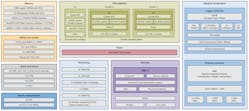This video is part of TechXchange Talks.
SAE Level 4 and Level 5 autonomous vehicles require significant amounts of computing power to support the necessary advanced driver-assistance system (ADAS) capabilities. Arm is providing IP that addresses these capabilities. I talked with Arm's Director of Automotive Partnerships, Robert Day, about what the company is doing in this space (see video above).
Arm provides a range of processor and accelerator designs that are incorporated into system-on-chip (SoC) solutions, which chip vendors are delivering to Tier 1 and OEMs to power ADAS in today's vehicles. One example is NXP's S32G network SoC family that supports communication in a domain-centric vehicle (see figure). Multiple Arm Cortex-M and Cortex-A processor cores are incorporated in the chip, including many that are configured in lockstep with other cores to provide the level of reliability and safety needed for automotive applications.
Building automotive-grade components isn't easy, and incorporating the range of processors and accelerators into a single chip can be a challenge, but they're essential for autonomous vehicles. This means including CPUs, GPUs, and machine learning into chips that can meet automotive standards. It also means that partnerships are needed, since one company simply can't provide all of the expertise needed to deliver a workable solution.
